Weapons
In addition to the many captured weapons pressed into service by the German Military, these are the iconic (and ideal) weapons issued to German soldiers in a front-line infantry unit.

Karabiner 98k
Karabiner 98k
Caliber: 7.92x57mm Patrone
Length: 43.6 inches
Weight: 8 lbs., 9 oz.
Magazine Capacity: 5 Rounds
The Karabiner 98

Gewehr 41 (G41 [M/W])
Gewehr 41 (G41 [M/W])
Caliber: 7.92x57mm Patrone
Length: 45 inches
Weight: 11lbs.
Magazine Capacity: 10 Rounds
By 1940, it became apparent that some form of a semi-automatic rifle with a higher rate of fire than existing bolt-action rifle models was necessary to improve the infantry’s combat efficiency. The Army issued a specification to various manufacturers, to which Mauser and Walther (hence the M or W suffix) submitted prototypes. However, strange design restrictions hamstrung the finished rifles and they were plagued with reliability problems. It is fed from a 5 round stripper clip into a non-detachable box magazine using 7.92x57mm Patrone ammunition. It has a rate of fire of 20-30 rounds per minute.

Gewehr 43 (G43) Karabiner 43 (K43)
Gewehr 43 (G43) Karabiner 43 (K43)
Caliber: 7.92x57mm Patrone
Length: 44.5 Inches
Weight: 9 lbs., 9 oz.
Magazine Capacity: 10 Rounds
The German invasion of the Soviet Union led to small numbers of the SVT-40 being captured and returned to Germany for examination- it was clearly superior to the G41 system, and simpler as well. In 1943, Walther combined a similar gas system with aspects of the G41(W) providing greatly improved performance. It was accepted and entered into service as the Gewehr 43, renamed Karabiner 43 in April 1944. It is fed from either the 5 round stripper clips or a 10 round detachable box magazine using 7.92x57mm Patrone ammunition. It has a rate of fire of 30-40 rounds per minute.
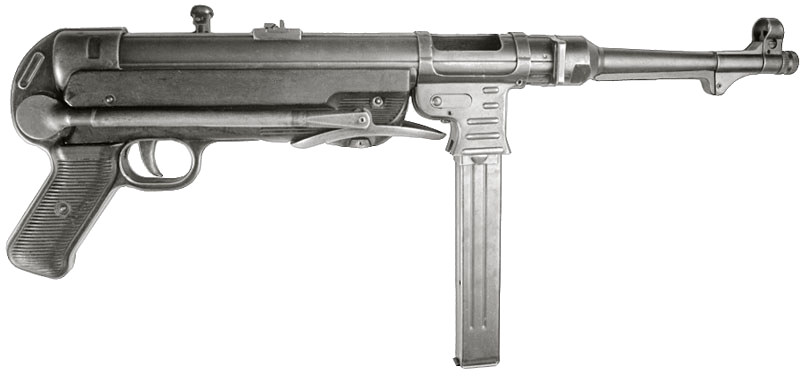
Maschinen Pistole 38/40 (MP38/40)
Maschinen Pistole 38/40 (MP38/40)
Caliber: 9x19mm Parabellum
Length: Stock folded – 24.75 inches, stock unfolded – 32.75 inches
Weight: 8 lbs., 14 oz.
Magazine Capacity: 32 Rounds
Designed in 1938 by Heinrich Vollmer with inspiration from its predecessor the MP 36. The MP 38 was a simplification of the MP 36, and the MP 40 was a further simplification of the MP 38, with cost-saving alterations, most notably in the more extensive use of stamped steel. It is fed from a 32 round detachable box magazine using 9x19mm Parabellum ammunition. It has a cyclic rate of fire between 400-550 rounds per minute, and a practical rate of 100 rounds per minute.
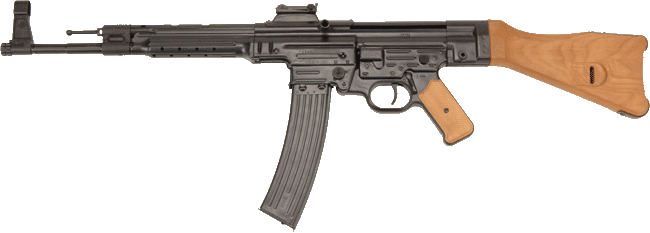
Maschinen Pistole 43/44 (MP43/44) Sturmgewehr 44 (STG44)
Maschinen Pistole 43/44 (MP43/44) Sturmgewehr 44 (STG44)
Caliber: 7.92x33mm Kurz Patrone
Length: 37 inches
Weight: 11 lbs., 8 oz.
Magazine Capacity: 30 Rounds
The STG44 was developed from the MP43/44, an earlier model that was constructed of pressed steel, gas operated, and is fed from a 30 round detachable box magazine using the intermediate 7.92x33mm Kurz Patrone ammunition. For propaganda reasons, it was renamed Sturmgewehr 44(Assault Rifle 44). It has a cyclic rate of fire between 500-600 rounds per minute, and a practical rate of 180-200 rounds per minute.
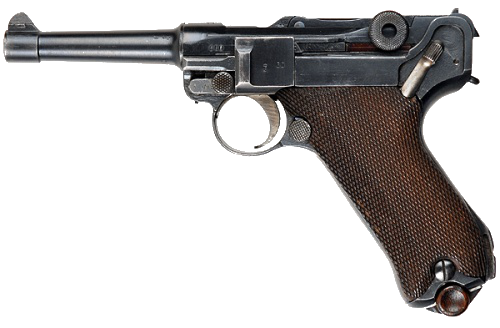
Luger Pistole, Model 1908 (P08)
Luger Pistole, Model 1908 (P08)
Caliber: 9x19mm Parabellum
Length: 8.75 inches
Weight: 1
Magazine Capacity: 8 Rounds
The Luger handgun was first issued in WWI and retained during the Wehrmacht’s expansion due to weapons shortages. The system of operation revolved around a recoil and toggle joint. Although preferred by officers, the P08 did not prove to be reliable under combat conditions and was replaced by the Walther P38. Its effective combat range is around 32 yards.
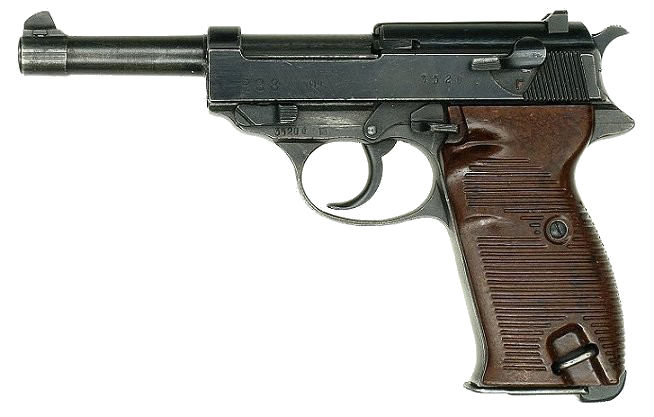
Walther Pistole, Model 1938 (P38)
Walther Pistole, Model 1938 (P38)
Caliber: 9x19mm Parabellum
Length: 8.6 inches
Weight: 2 lbs., 1.5 oz.
Magazine Capacity: 8 Rounds
In 1938, the Wehrmacht had begun to adopt the P38 as a replacement to the P08. Double action capability is due to its recoil operating system. The P38 was well accepted by the Wehrmacht and Waffen-SS due to its ability to operate in all types of adverse conditions. Its overall effective range was comparable to the P08.
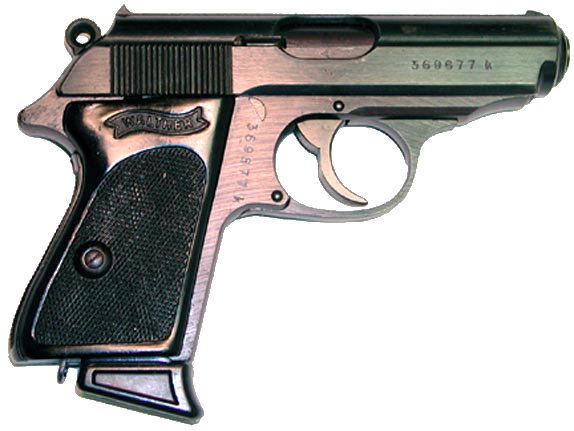
Walther PP/PPK
Walther PP/PPK
Caliber: 7.65mm / 9x19mm Parabellum
Length: 6.7 inches / 6.1 inches
Weight: 1 lb., 9 oz.
Magazine Capacity: 7/8 Rounds
The compact pistol that was used by officers and armored crews was the Walther PP. It was produced in 7.65mm and 9mm calibers. It was very compact in size and shape. Its effective combat range was around 32 yards. Its small size and the ease at which it could be concealed also made it popular with security personnel and police. The PPK was slightly smaller with an overall barrel length of 3.4 inches, and a magazine capacity of 7 rounds; apart from being slightly smaller, it was very similar to the PP.

Maschinengewehr Model 1934 (MG34)
Maschinengewehr Model 1934 (MG34)
Caliber: 7.92x57mm Patrone
Length: 48 inches
Weight: 23 lbs., 1 oz. with bipod
Magazine Capacity: Belt-

Maschinengewehr Model 1942 (MG42)
Maschinengewehr Model 1942 (MG42)
Caliber: 7.92x57mm Patrone
Length: 48 inches
Weight: 25 lbs., 5 oz. with bipod
Magazine Capacity: Belt-fed
The MG42 was adopted in 1942 by the Wehrmacht and first used in North Africa. The weapon was constructed of steel stampings and featured a quick change barrel system which enabled the operator to install a cool barrel in 5 seconds. The weapon had a recoil firing mechanism and fired 7.92mm ammunition at a cyclic rate of 1200-1400 rounds per minute. The practical rate of fire as an LMG is 250 rounds per minute, and as an HMG 500 rounds per minute. The effective range as an LMG is 600-800 yards and as an HMG is 2000-2500 yards.
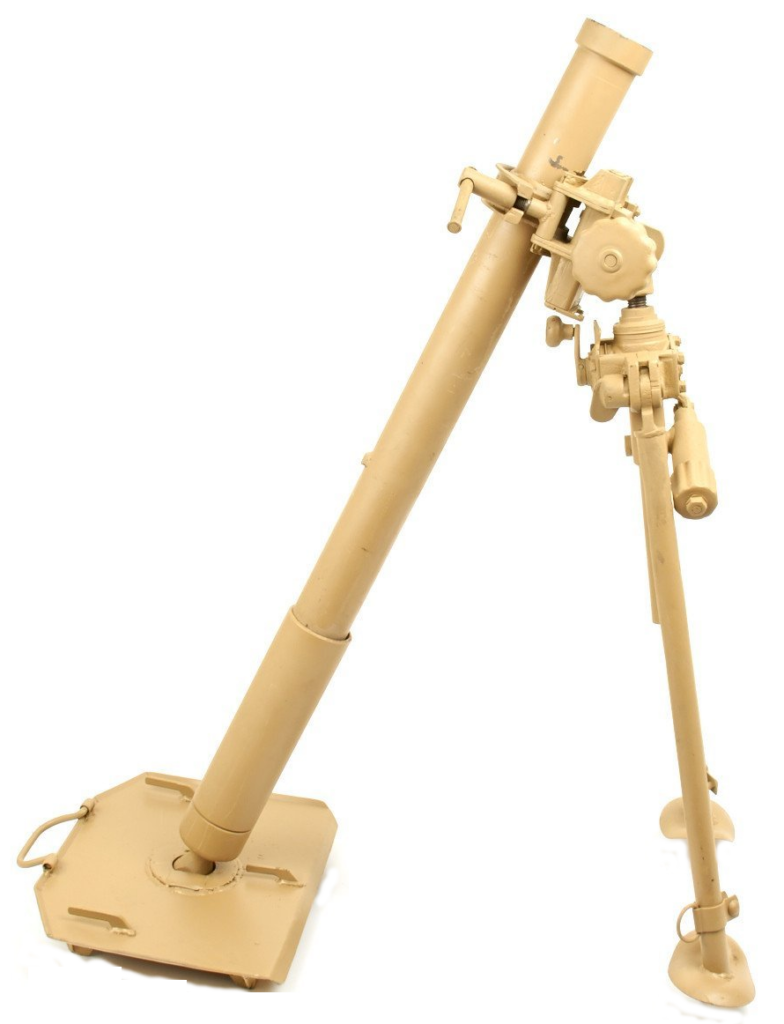
8cm Granatwerfer 34
8cm Granatwerfer 34
Caliber: 81.4mm (3.20 in)
Barrel Length: 45 in.
Weight: 136.6 lbs.
Maximum Firing Range: 1.5 miles
The 8cm Granatwerfer 34 (8cm GrW 34) was the standard German heavy mortar throughout World War II. It gained a reputation for extreme accuracy and rapid rate of fire. The design of the weapon was conventional and it broke down into three loads (barrel, bipod, baseplate) for transport. The barrel was smooth bore. Attached to its bipod were a traversing hand wheel, and a cross-leveling hand wheel below the elevating mechanism. A panoramic sight was mounted on the traversing mechanism yoke for fine adjustments. The mortar employed conventional 8 cm 3.5 kg high explosive or smoke shells with percussion fuses. The range could be extended by fitting up to three additional powder charges between the shell tailfins.